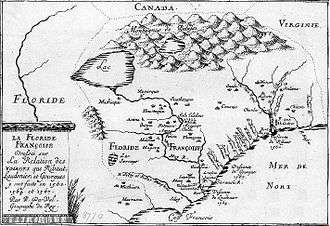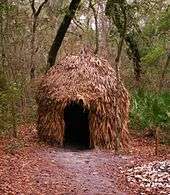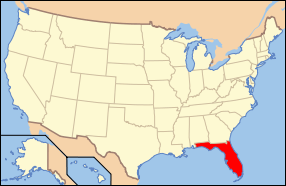Fort Caroline
| Fort Caroline National Memorial | |
|---|---|
|
IUCN category V (protected landscape/seascape) | |
 | |
 | |
| Location | Jacksonville, Florida, United States |
| Coordinates | 30°23′13″N 81°30′2″W / 30.38694°N 81.50056°WCoordinates: 30°23′13″N 81°30′2″W / 30.38694°N 81.50056°W |
| Area | 138.39 acres (0.56 km2) |
| Established | January 16, 1953 |
| Visitors | 145,736 (in 2005) |
| Governing body | National Park Service |
| Website | |
|
Fort Caroline National Memorial | |
  | |
| Nearest city | Jacksonville, Florida |
| Area | 128 acres (51.8 ha) |
| Built | 1564 |
| NRHP Reference # | 66000061[1] |
| Added to NRHP | October 15, 1966 |
Fort Caroline was one of the first French colonies in the present-day United States, located on the banks of the St. Johns River in what is now Jacksonville, Florida. It was established under the leadership of René Goulaine de Laudonnière on June 22, 1564, as a new territorial claim in French Florida and a safe haven for Huguenots. The French settlement came into conflict with the Spanish, who established St. Augustine in September 1565, and Fort Caroline was sacked by Spanish troops under Pedro Menéndez de Avilés on September 20. The Spanish continued to occupy the site as San Mateo until 1569.[2][2][3]
The original location is unknown. In 1953 the National Park Service established the Fort Caroline National Memorial along the southern bank of the St. John's River near the point that commemorates Laudonnière's first landing. The memorial is now managed as a part of the Timucuan Ecological and Historic Preserve although it remains a distinct National Park Service entity.
History
Charlesfort (1562)


A French expedition, organized by Protestant leader Admiral Gaspard de Coligny and led by the French Explorer Jean Ribault, had landed at the site on the May River (now the St. Johns River) in February 1562, here Ribault encountered the Timucuans who were led by Chief Saturiwa. Ribault then travelled to present-day South Carolina and with twenty-eight men built a settlement known as Charlesfort. Ribault then returned to Europe to arrange supplies for the new colony, but was briefly imprisoned in England on suspicion of spying as a result of the French Wars of Religion, which prevented his return to Florida.[4]
Without supplies or leadership, and beset by hostility from the native populations, all but one of the colonists sailed back to Europe after only a year. During their voyage in an open boat, they were reduced to cannibalism before the survivors were rescued in English waters.[5]
Fort Caroline (1564–1565)

Meanwhile, René Goulaine de Laudonnière, who had been Ribault's second-in-command on the 1562 expedition, led a contingent of around 200 new settlers back to Florida, where they founded Fort Caroline (or Fort de la Caroline) on a small plain formed by the western slope of the high steep bank later called St. Johns Bluff[6] on June 22, 1564. The fort was named for King Charles IX of France. For just over a year, this colony was beset by hunger, Indian attacks, and mutiny, and attracted the attention of Spanish authorities who considered it a challenge to their control over the area.[7][8]
On July 20, 1565, the English adventurer John Hawkins arrived at the fort with his fleet looking for fresh water; there he exchanged his smallest ship for four cannons and a supply of powder and shot.[9] The ship and provisions gained from Hawkins enabled the French to survive and prepare to move back to France as soon as possible. As Laudonnière writes: "I may saye that wee receaved as manye courtesies of the Generall, as it was possible to receive of any man living. Wherein doubtlesse hee hath wonne the reputation of a good and charitable man, deserving to be esteemed as much of us all as if hee had saved all our lives."[10] The French introduced Hawkins to tobacco, which they all were using, and in turn he introduced it to England upon his return.[11]
In late August, Ribault, who had been released from English custody in June 1565 and sent by Coligny back to Florida, arrived at Fort Caroline with a large fleet and hundreds of soldiers and settlers, taking command of the settlement. However, the recently appointed Spanish Governor of Florida, Don Pedro Menéndez de Avilés, had simultaneously been dispatched from Spain with orders to remove the French outpost, and arrived within days of Ribault's landing. After a brief skirmish between Ribault's ships and Menéndez's ships, the latter retreated 35 miles (56 km) southward, where they established the settlement of St. Augustine. Ribault pursued the Spanish with several of his ships and most of his troops, but he was surprised at sea by a violent storm lasting several days. Meanwhile, Menéndez launched an assault on Fort Caroline by marching his forces overland during the storm, leading a surprise dawn attack on Fort Caroline on September 20. At this time, the garrison contained 200 to 250 people. The only survivors were about 50 women and children who were taken prisoner and a few defenders, including Laudonnière, who managed to escape; the rest were massacred.[12]
As for Ribault's fleet, all of the ships either sank or ran aground south of St. Augustine during the storm, and many of the Frenchmen on board were lost at sea. Ribault and his marooned sailors were located by Menéndez with his troops and summoned to surrender. Apparently believing that his men would be well treated, Ribault capitulated. Menéndez then executed Ribault and several hundred Huguenots (French Protestants) as heretics at what is now known as the Matanzas Inlet. The atrocity shocked Europeans even in that bloody era of religious strife.[13] A fort built much later, Fort Matanzas, is in the vicinity of the site. This massacre put an end to France's attempts at colonization of the southeastern Atlantic coast of North America.

The Spanish destroyed Fort Caroline, but built their own fort on the same site. In April 1568, Dominique de Gourgues led a French force which attacked, captured and burned the fort. He then slaughtered the Spanish prisoners in revenge for the 1565 massacre.[13] The Spanish rebuilt, but permanently abandoned the fort the following year. The exact location of the settlement is not known.
Fort Caroline (20th-century reproductions)
The original site of Fort de la Caroline has never been determined, but it is believed to have been located near the present day Fort Caroline National Memorial. The National Park Service constructed an outdoor exhibit of the original fort in 1964, but it was destroyed by Hurricane Dora in the same year.[14][15] Today, the second replica, a near full-scale "interpretive model" of the original Fort de la Caroline, also constructed and maintained by the National Park Service, illustrates the modest defenses upon which the 16th-century French colonists depended.[16]
Proposed alternative location
On February 21, 2014, researchers Fletcher Crowe and Anita Spring presented a theory at a conference hosted by Florida State University's Winthrop-King Institute for Contemporary French and Francophone Studies that Fort Caroline was located not on the St. Johns River, but on the Altamaha River in southeast Georgia. The scholars believe period French maps, particularly a 1685 map of "French Florida" from the Bibliothèque nationale de France, support the more northern location. They further argue that the Native Americans living near the fort spoke Guale, the language spoken in what is now Coastal Georgia, rather than Timucua, the language of northeast Florida.[17][18] Other scholars have been skeptical of the hypothesis. University of North Florida archaeologist Robert Thunen considers the documentary evidence weak and believes the location is implausibly far from St. Augustine, considering the Spanish were able to march overland to Fort Caroline in two days amid a hurricane.[18] Chuck Meide, archaeologist at the St. Augustine Lighthouse and Museum, expressed similar criticism on the museum's blog, noting that other French and American scholars at the conference seemed similarly skeptical.[19][20]
See also
References
- ↑ National Park Service (2010-07-09). "National Register Information System". National Register of Historic Places. National Park Service.
- 1 2 Horowitz, Tony (2008). A Voyage Long and Strange: Rediscovering the New World. New York: Henry Holt & Co. ISBN 9780805076035.
- ↑ Morris, p. 470
- ↑ James Evans (12 September 2013). Merchant Adventurers: The Voyage of Discovery that Transformed Tudor England. Orion Publishing Group. p. 70. ISBN 978-0-297-86689-3.
- ↑ Sixteenth Century North America, Carl Ortwin Sauer, University of California Press, 1971, p. 197
- ↑ Davis, T. Frederick (October 1933). "Fort Carolina". Florida Historical Quarterly. 2. Florida Historical Society. 12: 77. Retrieved 6 March 2014.
- ↑ Bennett, Charles E. (1964). Laudonniere & Fort Caroline: History and Documents. Gainesville: University of Florida Press; reprint, Tuscaloosa: University of Alabama Press, 2001. p. 43. ISBN 978-0-8173-1122-3.
- ↑ Harry Kelsey (2003). Sir John Hawkins: Queen Elizabeth's Slave Trader. Yale University Press. p. 30. ISBN 978-0-300-09663-7.. See a translation of Laudonnière's account of the visit on pp. 543–45 of Richard Hakluyt, Principall Navigations, Voiages and Discoveries of the English Nation (London: George Bishop and Ralph Newberie, 1589).
- ↑ René Goulaine de Laudonnière, A notable historie containing foure voyages made by certayne French captaynes vnto Florida (trans. Richard Hakluyt; London: Thomas Dawson, 1587), 51–52.
- ↑ John Sparke, ed. by Henry S.Burrage (1906). "The Voyage Made by M. John Hawkins Esquire, 1565". Charles Scribner's Sons. pp. 122–126. Archived from the original (PDF) on March 25, 2016. Retrieved 10 July 2016.
- ↑ "The End of the Colony", National Park Service.
- 1 2 Morison, p. 470
- ↑ "Florida Historic Places - Fort Caroline National Memorial". National Park Service. Retrieved 2014-02-22.
- ↑ "Collections - Timucuan Ecological & Historic Preserve (U.S. National Park Service)". National Park Service. Retrieved 2014-02-22.
- ↑ "Fort Caroline National Memorial". FloridaParks.com. 2010-10-21. Retrieved 2014-02-22.
- ↑ "Oldest fortified settlement ever found in North America? Location of Fort Caroline may be in Georgia". Science Daily. February 21, 2014. Retrieved February 22, 2014.
- 1 2 Soergel, Matt (February 22, 2014). "Scholars say ancient Fort Caroline nowhere near Jacksonville". The Florida Times-Union. Retrieved March 14, 2014.
- ↑ "LAMP disputes new Fort Caroline claims". Keepers Blog, St. Augustine Lighthouse & Museum. February 22, 2014. Retrieved March 14, 2014.
- ↑ "Local archaeologist defends history of Fort Caroline". Historic City News. March 15, 2014. Retrieved March 16, 2014.
- Sources
- Lyon, Eugene (1976). The Enterprise of Florida: Pedro Menendez de Aviles and the Spanish Conquest of 1565-1568. Gainesville: University Press of Florida. ISBN 9780813005331.
- Morison, S. E. (1971). The European Discovery of America: The Northern Voyages AD 500-1600. New York: Oxford Press.
- McGrath, John T. (2000). The French in Early Florida: In the Eye of the Hurricane. Gainesville: University Press of Florida. ISBN 9780813023083.
- The National Parks: Index 2001–2003. Washington, D.C.: U.S. Department of the Interior.
External links
 Media related to Fort Caroline at Wikimedia Commons
Media related to Fort Caroline at Wikimedia Commons- Official website
- Short film entitled French in Florida: 1562 -1566:
- University of Florida online finding aid for Fort Caroline:
- The Fort Caroline Archeology Project - Official website
- Fort Matanzas National Monument
- Fort Caroline shown on an engraving by Jacques Le Moyne
- Les expéditions françaises en Floride (1562-1568) - in French by Hélène LHOUMEAU
- Robert Viking O'Brien's article on the French Florida colony from The Marjorie Kinnan Rawlings Journal of Florida Literature
- Davis, Kenneth C. (November 26, 2008). "A French Connection". New York Times.
- "Le Moyne's Florida Indians" - eyewitness written accounts and artwork of French artist Le Moyne while at Fort Caroline
- Historic American Buildings Survey (HABS) No. FL-521, "Fort Caroline National Memorial, Visitor Center, Jacksonville, Duval County, FL", 1 color transparency, 1 photo caption page
- "FOURTH EXPEDITION TO FLORIDA IN 1567, COMMANDED BY THE CHEVALIER DE GOURGUES." - written account of the de Gourgues revenge attack on Fort Caroline/San Mateo in 1567.

